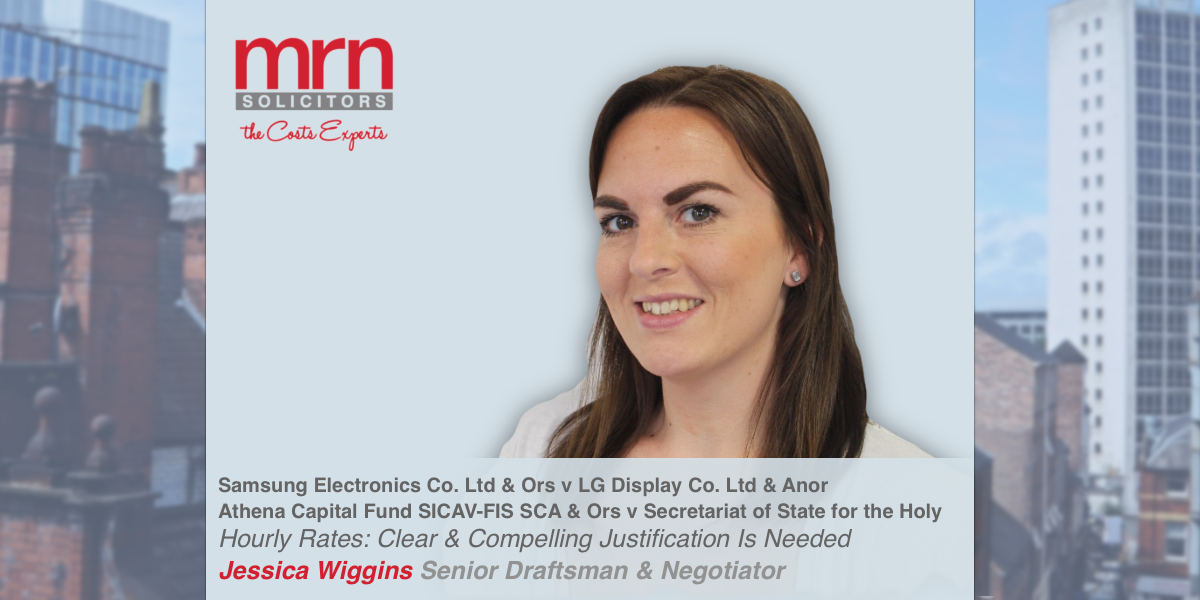As we know, the Courts have a wide discretion when it comes to costs and the decisions on hourly rates, in particular, can vary wildly which can make it very difficult to predict with a high degree of certainty the likely outcome of a case on Detailed Assessment. The recent guidance from the Court of Appeal on hourly rates in two cases is therefore particularly welcome.
First up was Samsung Electronics Co. Ltd & Ors v LG Display Co. Ltd & Anor (Costs) [2022] EWCA Civ 466. This was a one day appeal where the only issue between the parties was the appropriate forum of the Trial. The Respondent, LG, was successful and was awarded its costs of an appeal on the standard basis and a schedule of costs totalling £72,818.21 was submitted to the Court for summary assessment. The costs were billed in US dollars at rates of between US $1,045 and US $1,475.75 per hour for Grade A fee earners and between US $578 and US $918 for Grade C fee earners which were equivalent to rates of between £801.40 and £1,131.75 for Grade A fee earners and between £443.27 and £704 for Grade C fee earners.
The Appellant, Samsung, argued that the rates were well above the guideline hourly rates which for London 1, which applied to “very heavy commercial and corporate work by centrally based London firms”, were £512 for Grade A fee earners and £270 for Grade C fee earners.
The Court referred to Appendix 2 of the “Summary Assessment of Costs” guide published in the White Book and observed that the guide recognised that in substantial and complex litigation an hourly rate in excess of the guideline figures may be appropriate. The value of the litigation, the level of complexity, the urgency or importance of the matter, and any international element were given in the guide as examples of when rates beyond guideline might be appropriate. However, the Court also observed that it was important to have in mind that the guideline rates for London 1 already assumed that the litigation in question qualified as “very heavy commercial work”.
Perhaps to their downfall, LG did not attempt to justify its solicitors charging at rates substantially in excess of the guideline rates. Rather, they simply submitted “that its hourly rates are above the guideline rates, but that is almost always the case in competition litigation”. The Court did not consider this justification at all with Males LJ stating:
“If a rate in excess of the guideline rate is to be charged to the paying party, a clear and compelling justification must be provided. It is not enough to say that the case is a commercial case, or a competition case, or that it has an international element, unless there is something about these factors in the case in question which justifies exceeding the guideline rate.”
On the basis this was a one day Appeal which was not document heavy and where the amount claimed (£900,000) was considered to be modest by commercial standards, the Court was of the view that there was no justification for rates in excess of guideline and as a result, LG’s costs were summarily assessed in the sum of £55,000.
Hot on Samsung’s heels was the case of Athena Capital Fund SICAV-FIS SCA & Ors v Secretariat of State for the Holy See (Costs) [2022] EWCA Civ 1061. In this case the Court of Appeal was considering the appropriate amount to award to the successful Appellant by way of a payment on account of costs.
The Court expressed surprise that, in a matter where the appeal had been listed for 1.5 days but had been concluded in 1 day, the parties’ statements of costs collectively totalled £730,000. Of this sum, £380,000 were costs of the Appellant which included Counsel’s fees of approximately £200,000 and profit costs of £175,000 which were claimed at rates “well in excess” of guideline hourly rates.
Males LJ reiterated his comments in Samsung that “clear and compelling” justification was required if a party wanted to recover rates in excess of guideline. He went on to say:
“The only issue was whether the judge had exercised his discretion wrongly in granting a case management stay. It would be highly regrettable if a one-day appeal to this court, even in a commercial case involving international parties and some degree of complexity, could not be conducted without incurring the risk of liability for lawyers’ fees on this scale.”
In his judgment, Males LJ also commented on the comparison often drawn by parties between their own costs and those of their opponent, stating “the costs payable by the losing party on the standard basis are limited to those which are reasonable and proportionate. Where the costs of the paying party are also disproportionately high, that can make no difference…”
The key takeaway from these cases therefore is that if you are seeking hourly rates in excess of guideline, it is not enough to simply say the case is a “commercial case”; a “clear and compelling justification” must be given. When submitting your claims for costs in such matters you may therefore want to give consideration to including a statement in the narrative to your Bill, within your Replies and/or within a stand-alone statement detailing why in that particular instance rates beyond guideline are justified.


